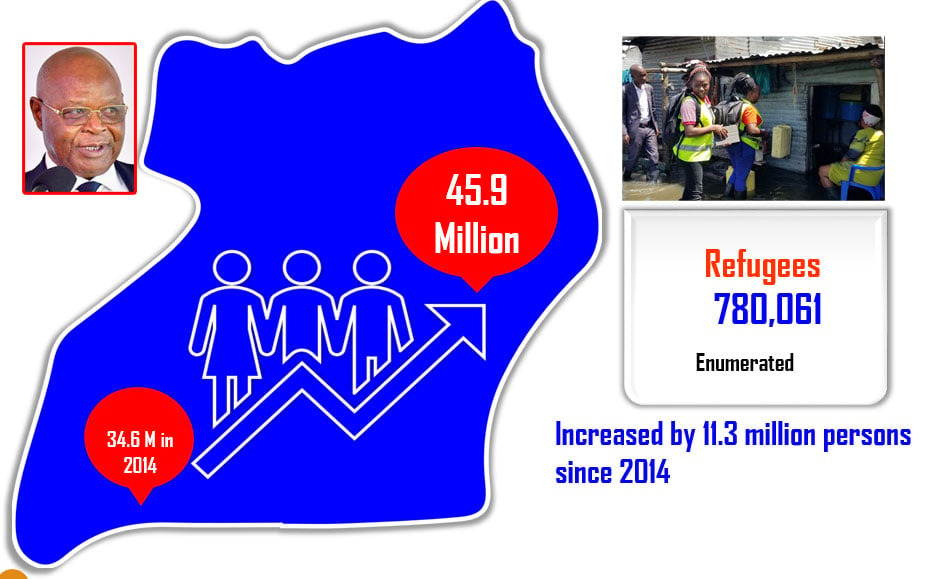Regions with fastest growing population

Enumerators interract with a respodent during the census night on May 9. Karamoja and West Nile registered the fastest rate of population growth over the past decade. photo/file
What you need to know:
West Nile, which has huge refugee numbers, and Karamoja, a rising mining hub, post fastest population growth rate although Buganda, Busoga and Ankole in descending order remain the most populated and potentially swing regions for 2026 presidential elections.
Karamoja and West Nile registered the fastest rate of population growth over the past decade, at annual growth rate of 4.2 and 3.9 respectively, according to the 2024 National Housing and Population Census preliminary results released yesterday.
Our analysis, however, shows that the population rise in West Nile is artificial because the government enumerated refugees --- who UN refugee agency record shows number 782,687 in Yumbe, Madi-Okollo, Terego, Adjumani and Obongi districts – during last month’s census.
This suggests the number of Ugandan citizens in north-western Uganda is significantly lower than the nearly 4 million reported by Uganda Bureau of Statistics (Ubos), reflecting a 47 percentage point jump from the 2014 census conducted before renewed violence in South Sudan from 2016 push millions across the border.
UBOS officials did not readily explain the increase in faster population growth in the semi-desert north eastern corner, although improved road and other infrastructure coupled with accelerated mining has sparked scramble for land and settlement for business in Karamoja.
Despite the pattern of faster population growth, overall Buganda, at 11 million people, remains Uganda’s most populated followed by Busoga (4.4m) with West Nile coming third. In fourth position is Ankole with a population of 3.6m followed in descending order by Tooro (3.4m), Bunyoro (2.7m), Lango (2.5m) and Teso (2.5).
The regions with smaller populations are Bukedi (2.4m), Acholi (2m), Kampala (1.9m) with Kigezi, at 1.8m, having more people than only Karamoja, the least populated (1.4 million).
Overall, Uganda’s population has increased by 11 million over the past decade, raising the prospects of higher voter numbers at the next ballot.
The country goes to the polls in early 2026 and the release of the broader census figures comes days to the start of July during which Electoral Commission Chairman, Justice Simon Byabakama, said they expect to start demarcating electoral areas and polling stations.
“We are only waiting for money which has been allocated to us in the new budget,” he said on the sidelines of engagement with youth at Makerere University in Kampala on June 14.
The EC projected to register six million new voters during implementation of its Shs1.3 trillion roadmap ahead of the forthcoming elections, contrasting an increase in the number of Uganda’s total population by just 10 million over 10 years.
With Uganda Bureau of Statistics (UBOS) reporting that seven in every 10 Ugandans are aged 30 or under --- put another way, youth – out of who 20 million are in the 0-14 age bracket, questions swirl over how EC would possibly register 6 million new voters.
Under the law, only citizens aged 18 years and above are eligible to register and vote, although the electoral body can as of this year enroll 16 and 17-year-olds if they would have attained the majority age by voting time in 2026.
The new census data is not disaggregated by age 18 and above, and the actual voter numbers in the country are not expected until the Electoral Commission conducts fresh voter registration that the government says will predicate on National Identification and Registration Authority (NIRA) records.
There were 18 million voters enrolled for the 2021 elections which President Museveni won with 58 percent against 35 percent of votes that runner-up Robert Kyagulanyi, alias Bobi Wine, of the National Unity Platform garnered.
NUP also swept votes in Buganda, the country’s most populous region, and Busoga that until the 2021 ballot was a stronghold of the ruling National Resistance Movement (NRM) party, but it did not make much inroads into other parts of the country to secure victory.
In addition, nearly seven million registered voters, which outnumber the six million that re-elected the incumbent President, stayed away.
This wide gap between registration and ballot casting, which some observers have in the past linked to voter fatigue and fear due to militarisation of the exercise, has been an inconclusive national course with the EC saying such voters make resources used for their registration to go to waste.
The EC’s data for 2021 General Elections shows the highest number of voters, at 5.4 million, were registered in the central (Buganda), which is Uganda’s most populous, followed by western at 5.2 million voters, eastern 4.2 million and northern (3.2m).
If voter numbers from the census data reflect a similar pattern, it would mean Buganda, again the most populated with 11 million people, would be a swing region.
Kampala with 1.8 million people, although geographically within Buganda, is by law distinguished as Uganda’s capital and its population is counted separate from Buganda.
Other regions with higher populations – where voter numbers would likely be correspondingly high to influence the outcome of the next election – are (in descending order) Busoga, West Nile Ankole, Tooro, the oil-rich Bunyoro, Lango, Teso, Bukedi and Acholi. Others are Kampala and Kigezi and Karamoja.




